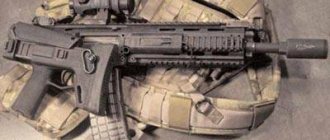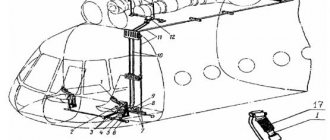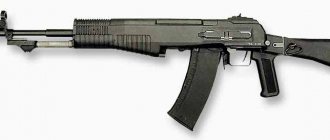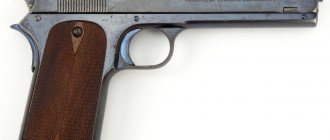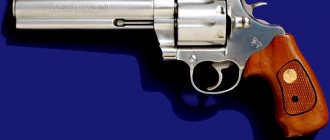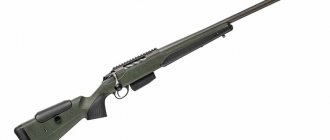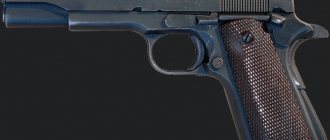Colt CAR-15/XM-177 Commando (USA)
Colt CAR-15 - the earliest version
Colt XM-177E1
Colt Commando (model 733, modern version with spent cartridge deflector and bolt rammer)
Performance characteristics for the modern version of Colt mod 933 Commando
Caliber
: 5.56×45 mm (.223 Remington)
Automatic type
: gas operated, locking by turning the bolt
Length
: 680 - 762 mm
Barrel length
: 292 mm
Weight
: 2.44 kg without magazine
Rate of fire
: 750 rounds per minute
Magazine
: 30 rounds
The compact machine gun (assault carbine, or according to the internal classification of the Colt company - submachine gun) Colt Commando was created in 1965 at the request of American special forces operating in Vietnam. Colt engineers simply shortened the barrel of the M16 rifle by 2 times (from 508 to 254 mm), and also shortened the plastic butt by 76 mm, making it sliding. Otherwise, the new machine gun, called the CAR-15, was no different from the early M16. Especially for the US Air Force, based on the CAR-15, Colt developed a version of the CAR-15 Survival rifle, intended for airplane and helicopter pilots as a survival weapon in enemy territory. This version had a metal non-folding butt, a round fore-end and a shortened pistol grip.
Initial experience with the CAR-15 in Vietnam demonstrated a number of problems. Due to the short barrel, the sound of the shot was excessively loud, and the considerable flash from the shots blinded the shooter in the twilight and gave away his position to the enemy. The solution was to install a new, extended flash suppressor, and the new version was adopted by the US Army under the designation XM-177E1 Commando. The XM-177E1 had a tubular section forend and a telescopic metal retractable stock. The receiver from the M16E1 had a bolt rammer. In 1967, the Commando was further modernized by lengthening the barrel to 292 millimeters.
Later, with the adoption of the M16A2 and M16A3 assault rifles, new Colt Commando variants also received new receivers, with spent cartridge deflectors and (some models) with a universal guide instead of an integral carrying handle like the M16A3. Various versions of the Commando are in service with the US Special Forces as well as in a number of other countries, including Israel and the Philippines.
From a technical point of view, the Colt Commando is almost no different from its contemporary versions of the M16 rifle - it has the same aluminum alloy receiver, consisting of two parts, the same automatic system with direct discharge of powder gases into the bolt frame and a rotating bolt with 8 lugs . The return spring is located in the butt, and therefore all Commando variants are equipped not with folding sideways or downwards, but with telescopic butts. Depending on the model, the Commando can have a full-automatic fire mode or a 3-round burst fire (in addition to the mandatory single-shot mode).
| Colt CAR-15 Early version |
In 1965, by order of US special operations forces, Colt developed a compact machine gun (assault carbine, or, according to Colt’s internal classification, a submachine gun) model Colt Commando, based on the M16 assault rifle.
| CAR-15 Survival rifle | XM177E2 | Model 733 | Model 933 | |
| Caliber, mm | 5.56×45 NATO (.223 Remington) | |||
| Length, mm - butt unfolded - butt folded | 737 —— | 787 711 | 762 681 | 762 681 |
| Barrel length, mm | 254 | 292 | 292 | 292 |
| Weight, kg | 2.15 | 2.43 | 2.6 | 2.4 |
| Store, Col. cartridges | 20, 30 | |||
| Effective Firing Range, m | 150 — 200 | |||
| Rate of fire, RPM | 750 |
When creating a new weapon, Colt engineers shortened the barrel of the M16 rifle by 2 times (from 508 to 254 mm), and also shortened the plastic butt by 76 mm, making it sliding. Otherwise, the new machine gun, designated CAR-15, was no different from the earlier M16 model.
The new machine gun was intended for use by American special forces and combat vehicle crews.
Especially for the US Air Force, based on the CAR-15, Colt developed the CAR-15 Survival rifle, intended for airplane and helicopter pilots as a survival weapon in enemy territory. This version had a metal non-folding butt, a round fore-end and a shortened pistol grip.
| CAR-15 Survival rifle |
For US special forces who fought in Vietnam, the XM177 model was developed based on the CAR-15.
However, initial experience with the XM177 in Vietnam demonstrated a number of problems. Due to the short barrel, the sound of the shot was excessively loud, and the strong flash from the shots blinded the shooter in the twilight and gave away his position to the enemy.
The solution to the problem was the installation of a new, extended, improved flame arrester. A new version of the machine gun was adopted by the US Army under the designation XM177E1.
| XM177E1 |
In addition, the XM177E1 was structurally similar to the M16A1 rifle, but had a 254 mm long barrel, a tubular section forend and a telescopic butt.
In 1967, the XM177E1 assault rifle was modernized by lengthening the barrel to 292 millimeters, which made it possible to use it with an installed under-barrel grenade launcher. The new model was designated XM177E2.
| XM177E2 With mounted grenade launcher |
After the end of the Vietnam War, the US Army lost interest in compact assault rifles. However, Colt, after adopting the M16A2 assault rifle into US service in the early 1980s, is creating a new model of the assault rifle.
The new version of the Colt Commando Model 733, as well as the M16A2 assault rifle, was adapted for the new SS109 cartridge of 5.56×45 mm NATO caliber, received a heavier barrel with a rifling pitch of 1:7, improved sights, as well as a firing mode with a cut-off of 3 shots .
| Colt Commando Model 733 |
After the M16A3 and M16A4 assault rifles were adopted by the United States in the 1990s, the Colt Commando Model 933 was developed based on their principle, which received a new receiver with a universal guide instead of an integral carrying handle, as well as the ability to install additional guides instead of the forend.
Colt Commando Model 733 With partial disassembly
From a technical point of view, the compact assault rifle of the Colt Commando model is almost no different from the corresponding variants of the M16 rifle.
The machine gun has the same aluminum alloy receiver, consisting of two parts, the same automation with direct discharge of powder gases into the bolt frame and a rotary bolt with 8 lugs.
The return spring is located in the butt, and therefore all Commando variants are equipped not with folding sideways or downwards, but with telescopic butts.
Depending on the model, the Colt Commando may have full-automatic fire or 3-round burst fire (in addition to the mandatory single-shot mode).
Various variants of the Colt Commando were adopted by US special forces and were also supplied to other countries, including Israel and the Philippines.
| Colt Commando Model 933 |
Operating countries
IDF soldiers with CAR-15 (November 13, 2007)
- Great Britain
- Vietnam - a number of captured carbines remained after the end of the Vietnam War
- Israel
- El Salvador - received in the 1980s under a military assistance program from the United States[3]
- USA - carbines entered service with special operations forces and certain categories of US military personnel, they were also used in police special forces[4] (at the same time, in the 1990s, the police began selling old CAR-15 models, replacing them with the CAR-15A3 version)[1] . The CAR-15 remained in service with the Delta special forces even in 2008, after receiving more modern M4 carbines[5]
- Philippines
- South Korea - a certain amount was transferred in the 1970s from the United States for special forces[6]
- South Vietnam[1].
Notes
- ↑ 12345678910
Ken Hakethorn. American AKM: Colt combat carbine // Soldier of Fortune magazine, No. 3 (30), March 1997. pp. 38-51 - Ed Poulson. Even closer and quieter. New silencers meet the requirements of close combat // Soldier of Fortune magazine, No. 7 (22), July 1996. pp. 37-43
- Julio A. Montes. Infantry weapons of the Salvadoran Forces // “Small Arms Review”, May 2000
- Leroy Thompson. Anti-terror. Hostage Rescue Guide. M.: FAIR PRESS, 2005. pp. 123-125
- « Colt M4 assault rifle, M16A2 assault rifle, Steyr AUG assault rifle, SOPMOD M4A1 assault rifle,
CAR-15 assault rifle and Colt Model 733 assault rifle
» Delta Force weapons and equipment // Mike Ryan. The Operators: Inside the World's Special Forces. Skyhorse Publishing, 2008. p. 187. ISBN 978-1602392151. - « Korean Army/Marines got M16A1s during the Vietnam War from US military aid, but it wasn't a large enough quantity to arm all Korean active military personnel... Spec-Ops Command was desperately in search of new weapons.
They used a hodgepodge of weapons, from WWII-era M2 Carbines, M3 Greaseguns, to the brand-new Ingram M10, Israeli Uzi or Colt CAR-15s (XM177s) and M16s, but none of them were in enough quantity for homogenous issue, and maintaining such a variety of weapons was also a logistical nightmare.
» Heebum Hong. The evolution of K1/K2 families in the ROK military // “Small Arms Defense Journal” volume 9, no.5 (December 1, 2017).
CAR-15
CAR-15 rifle (also known as M16 rifle)
M16A1 rifle
Model 603
The CAR-15 Rifle, originally adopted by the United States Army as the XM16E1 and later as the M16A1, and
the Model 604
CAR-15 Rifle, which was adopted by the United States Air Force as the M16, formed the core of the AUTO-15 family.
However, the US military had already made procurement commitments before Colt created the CAR-15 weapon system concept. The key difference between the 603
and
604
is that the former has a forward assist that allows the user to manually close a stuck bolt.
Heavy assault rifle CAR-15 M1
The CAR-15 M1 Heavy Assault Rifle was a heavy-barreled version of the standard AR-15 with an attached bipod, intended for use as a combat automatic weapon (SAW). Designed to feed from 30-round box magazines.
Heavy assault rifle CAR-15 M2
The CAR-15 M2 Heavy Assault Rifle was a belt-fed modification of the standard CAR-15, with a heavy barrel and bipod. It was only produced as a prototype and was not sold.
CAR-15 Carbine
Bushmaster Dissipator semi-automatic barrel, which uses a similar short barrel and standard hand protection length to the CAR-15 Carbine.
Model 605A
The CAR-15 Carbine was a shortened version for situations where longer weapons might be unwieldy, such as aboard vehicles or helicopters. It was an improved version of the AR-15 SBR, which was a shortened version of the Colt Armalite AR-15. The only significant difference from the M16 rifle was that the barrel was shortened to 15 inches (381 mm) in length so that it ended just before the base of the front sight. Due to the shorter barrel, no lugs were provided for attaching a bayonet. One prototype used a shorter handguard and a 16-inch (410 mm) barrel.
Model 605B
did not have forward assist, but did have a four-way selector switch (designed by Foster Racine in December 1966) so the user could select safe, semi-automatic, three-round burst or fully automatic fire modes. Unlike the standard three-position group, the four-position group went from (clockwise from the 9 o'clock position) safe, full-automatic, semi-automatic and finally explosive. The selector itself had 360 degree rotation and could be moved either clockwise or counterclockwise, unlike standard groups. Instead of a three-shot burst, the cam could be changed to a two-shot or six-shot burst. Both versions used a rifle-length stock.
Back in 1964, the US Navy SEALs used the CAR-15 carbine. [1]
CAR-15 submachine gun (also known as CAR-15)
CAR-15 submachine gun
In late 1959, Colt introduced the AR-15 tanker model. It was the first AR-15 with a retractable stock, measuring only 26 inches (660 mm) in overall length with the stock retracted. The retractable stock resembled a shortened version of the fixed stock, but a two-position latch recessed into the rear allowed it to be extended and locked into position, increasing the length of pull by 2.7 inches (69 mm). The barrel was too short to accommodate a bayonet, so the submachine gun did not have a bayonet lug. In 1965, Colt introduced the new Model 607
The CAR-15, which is an improved version of the Colt Armalite AR-15 Tanker Model with some modifications over the M16. It was a compact weapon for use by special forces and vehicle crews. The dictionary definition of a submachine gun is an automatic firearm that fires pistol caliber cartridges. However, manufacturers such as Colt, Heckler & Koch, and Zastava Arms call compact carbines submachine guns to emphasize their short length and differentiate them from longer carbines.
About 50 TsAR-15 submachine guns were manufactured. Most were issued to the Navy SEALs and Army Special Forces, although some were also issued to Army K-9 units. Since it never went into mass production, the CAR-15 PP was assembled from existing spare parts. The first models were made with M16 receivers without forward gears and with short pistol grips from Survival Rifle (see below). Later model 607A
was made with an
XM16E1
front assist receiver and a standard pistol grip. The handguard was made from a full length rifle handguard by cutting it in half and using either the front or rear pair, after machining the ends to fit the slip ring and handguard cap.
Due to their short barrel, CAR-15 submachine guns suffered from loud and bright muzzle blast, and a number of muzzle devices were developed to reduce this. Initially, submachine guns were equipped with the "duck stick" of the standard M16 rifle or a tri-bar flash hider, which did not solve the problem. In September 1966, Colt developed a 3.5-inch (89 mm) retarder that reduced noise and muzzle flash, which also increased the weapon's reliability by increasing the amount of back pressure. However, the moderator created its own problems, such as heavy barrel fouling and harsh yaw of tracer bullets. A 4.25 in (108 mm) long retarder with six slots and an expansion chamber, which further reduced noise and flash, replaced the previous muzzle device and became standard on the SMG and Commando series, but problems with fouling and tracers persisted. [2]
Colt Commando (also known as CAR-15, XM177 and GAU-5)
A member of a US Air Force combat control team with a GAU-5 carbine and an oversized flash suppressor.
A U.S. Air Force security policeman aims his Colt Commando during a live-fire demonstration as part of Operation Desert Shield. Note: large flash arrester
The Colt Commando was not originally part of the CAR-15 weapon system, but was added in 1966 in response to the US military's desire for a shorter M16 and without the disadvantages of the Model 607
.
Colt engineer Rob Roy designed a simpler two-position telescoping aluminum stock to replace the complex retractable triangular version. The flimsy and irregular triangular handguards were replaced with reinforced round handguards. Each half of the round handguard is identical, which simplifies logistics by not requiring a top/bottom or left/right pair. The Model 609
Commando has forward assist, but the
Model 610
Commando does not.
The Model 610B
with a four-way selector was available but not used by the US military. All versions are equipped with a 4.25 inch (108 mm) retarder.
The XM177 uses a unique flash suppressor, sometimes called a flash or sonic retarder, for its 10-inch (250 mm) barrel. This device is 4.2 inches (110 mm) long and was designed primarily as a counterweight, as the shorter barrel makes the weapon unwieldy. [3] This device greatly reduces the flash signature and slightly reduces the sound signature, making the short-barrel carbine generally sound louder, similar to the long-barrel M16A1. [4] Although it has no internal baffles and does not completely reduce the sound signature to subsonic levels because it changes the sound level of the weapon, the U.S. Bureau of Alcohol, Tobacco Firearms and Explosives has stated that this muzzle device is a sound suppressor . and regulates its civilian procurement in the United States. [4]
Model 610
was classified as
XM177
[5] but adopted by the Air Force as
the GAU-5/A
Pistols Gun (GA standing for automatic pistol and U is a complete unit rather than a set of parts: the popular "aircraft pistol unit" and explanations for "automatic gun" are backronyms [ 6] ).
On June 28, 1966, the Army purchased 2,815 Commando Model 609
CAR-15s, officially designated
5.56 mm
guns XM177E1
. [5] As part of the contract, Colt was required to supply every XM177E1 with seven 30-round magazines, but Colt was unable to build a reliable 30-round curved magazine that would fit well in the M16 magazine, so most XM177E1s were shipped. with magazines for 20 rounds. The exception was the 5th Special Forces Group, which received a total of four early 30-round magazines. Colt completed delivery of the purchased XM177E1s in March 1967.
In 1967, in response to field testing, Colt increased the Commando's barrel length from 10 to 11.5 inches (254 to 292 mm). The increased length reduced noise and muzzle flash, and also allowed the installation of a Colt XM148 grenade launcher. A metal tab has been added to the moderator for mounting the XM148 and rifle grenades. [7] The cameras were chrome plated. Commandos with longer barrels were called Model 629
and
Model 649
.
The 629
Commando has forward assist;
The 649
Commando does not.
In April 1967, the Army purchased 510 Model 629
for use by troops assigned to the Military Assistance Command, Research and Observation Group, Vietnam (MACV-SOG), and designated them
XM177E2
.
[5] Delivery was completed by the end of September 1967. The Air Force adopted a model similar to the GAU-5A/A
without the forward assist feature.
Sources dispute whether it was a Colt Model 630
or
Model 649
. [5] According to John Plaster and other sources, the lack of 30-round magazines continued to be a problem, and SOG operators resorted to pooling their personal resources and purchasing larger capacity magazines from the US civilian market. [8] Problems with range, accuracy, barrel fouling, and use of tracer bullets continued to plague the XM177 series, but Colt estimated that a six-month, $400,000 program would be required to conduct a full ballistic and kinematic study. There were also recommendations for a 29-month research and development program costing $635,000. Both recommendations were rejected by the US military as US ground forces' participation in the Vietnam War gradually declined. Production of the CAR-15 Commando ended in 1970.
CAR-15 Survival Rifle
Model 608
The CAR-15 Survival Rifle was intended for use by downed aircraft crews. Thanks to the CAR-15's modular design, the survival rifle could be divided into two parts and placed with four 20-round magazines in the pilot's seat. Resembling the Colt Commando, it also has a 10-inch (250 mm) barrel and has an overall length of 29 inches (740 mm) when assembled. The Survival rifle used a fixed tubular aluminum stock with a plastic coating and a round handguard, which were not used in other versions of the CAR-15, and had neither an assist nor a bayonet lug. The pistol grip was cut down and the muzzle was fitted with either a conical flash suppressor or a 3.5 in (89 mm) retarder.
Story
The creation of the first automatic carbine based on the AR-15 began in mid-1964 as a weapon for special forces, aircraft pilots and some other categories of military personnel[1]. To reduce its size, engineers shortened the M16 barrel from 508 to 254 mm, and replaced the fixed stock with a telescopic one, making the weapon another 76 mm shorter.
However, the short barrel did not ensure complete combustion of the gunpowder, and, as a result, the sound of the shot was too loud and the flash when firing was too large caused discomfort and unmasked the shooter. Based on the results of operation, in 1968 it was decided to make changes to the design of the weapon (at the same time, production of the XM177 version was discontinued, and the previously released XM177 in 1969-1970 was withdrawn from the US troops)[1].
The upgraded version of the XM-177E1 Commando, which eliminated these shortcomings, was put into service.
In 1983, the Canadian company Diemaco developed the Diemaco C8 automatic carbine based on the Diemaco C7.
for the Canadian Armed Forces, after which in 1984 the US government commissioned the development of an automatic carbine based on the M-16A2 design. At the development and testing stage, the carbine was named XM4, and in 1994 it was officially adopted by the US armed forces under the name M4 automatic carbine as a replacement for CAR-15 automatic carbines.
Since the early 1990s, the production of CAR-15 carbines with a telescopic stock made of aluminum alloy with a nylon coating was discontinued; all CAR-15 carbines manufactured by Colt began to be produced with a new buttstock made of glass-filled nylon[1].
In connection with the spread of body armor (which provided protection against shots from 9-mm submachine guns), the development of a new silencer for the 5.56-mm CAR-15 carbine began, by order of the FBI, for US police special forces. As a result, in the mid-1990s, designer Lynn McWilliams developed for the CAR-15 a removable muffler weighing 714 grams and 190 mm long in a stainless steel case (the production of which was mastered) [2].
